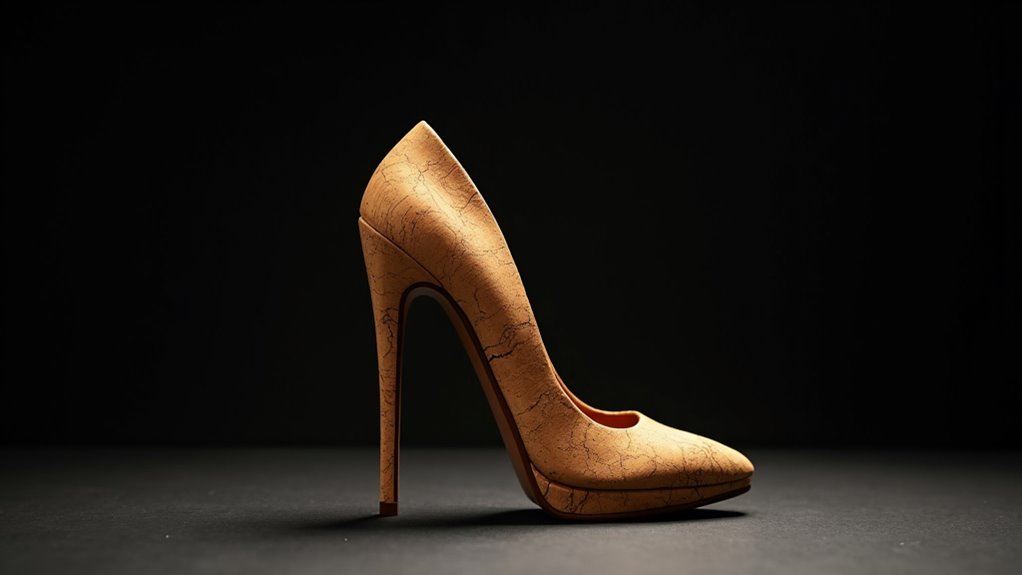There may be products. Products are independently selected by our editors. We may earn an affiliate commission from the links with no charge to you, example: as Amazon Affiliate.
When Christian Louboutin introduced recycled ocean plastic in his 2021 collection, we witnessed a pivotal shift in luxury footwear manufacturing. Let’s consider how alternative materials are reshaping the foundations of high heel design, from mushroom leather to bioplastics. We’re seeing traditional shoemaking transform as designers balance sustainability with the demanding requirements of heel construction. While these innovations promise to reduce environmental impact, they’ve raised important questions about durability and performance. The intersection of eco-conscious materials and high-end fashion presents both exciting possibilities and significant challenges that demand our attention.
Key Takeaways
- Mycelium-based components and bioplastics offer fully biodegradable alternatives while maintaining structural integrity in high heel design.
- Natural fibers from cork, banana, and fruit leather provide sustainable alternatives with excellent strength-to-weight ratios.
- Recycled plastics and textiles reduce environmental impact while preserving essential biomechanical properties for heel construction.
- 3D printing technology enables complex designs using recycled materials, minimizing waste in high heel production.
- Bio-based materials like Apple Leather and Bloom Algae revolutionize heel design through waste reduction and circular principles.
Traditional High Heel Materials
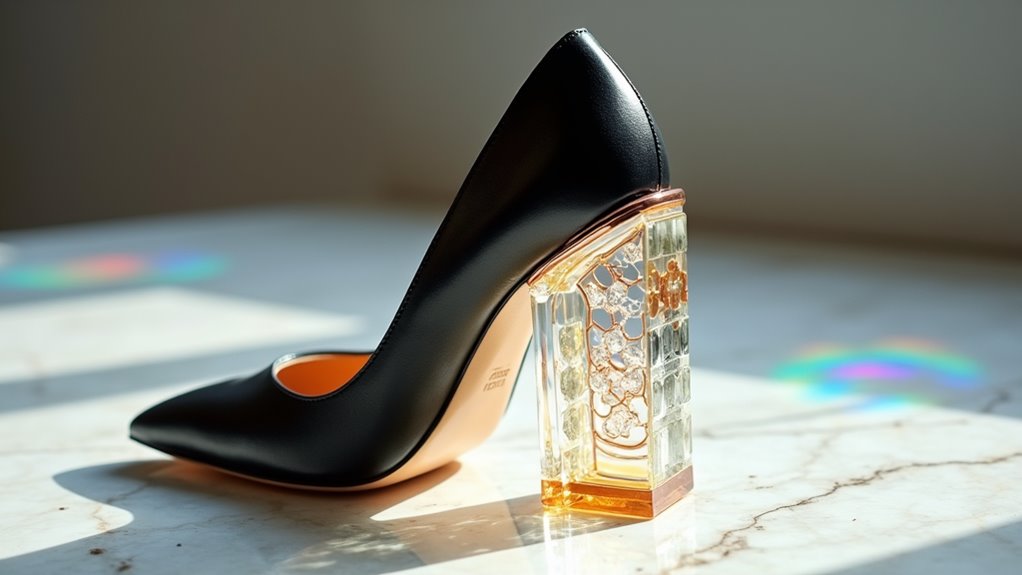
While high heels have become a staple in fashion, their traditional materials present significant environmental and health concerns.
We’re seeing alarming data about chrome-tanned leather’s impact, affecting 16 million people through chromium exposure. Similarly, PVC components in traditional high heel materials continue to pose chronic health risks to manufacturing communities.
We must consider how conventional cotton elements in shoe construction expose approximately 7 million individuals to dangerous pesticides.
The synthetic rubber components, making up 70% of manufacturing materials, release toxic chemicals into our environment. Additionally, standard footwear dyes contribute to 17-20% of global industrial water pollution.
These statistics underscore why we’re actively researching recycled materials and innovative alternatives to reshape the future of high heel design.
The industry is shifting toward tech-enhanced footwear that combines sustainable materials with modern innovations.
Sustainable Material Innovations
We’re witnessing a transformative shift in high heel design as manufacturers integrate eco-friendly materials like bioplastics and Mycelium-based components, which offer biodegradable alternatives to conventional petrochemical-derived materials.
Our industry’s commitment to sustainability now encompasses recycled plastics and textiles in structural components, reducing virgin material consumption while maintaining essential biomechanical properties.
Through innovative composite development, we’re combining natural fibers with advanced synthetics to create high-performance materials that optimize both environmental responsibility and wear characteristics.
The growing demand for sustainable footwear options has pushed designers to explore renewable materials that minimize environmental impact while maximizing style and comfort.
Eco-Friendly Material Breakthroughs
As sustainable innovation reshapes the footwear industry, breakthrough eco-friendly materials are revolutionizing high heel design through renewable resources and waste reduction technologies. We’re witnessing transformative sustainable materials like Bloom Algae and Mycelium-based composites that deliver superior performance while minimizing environmental impact.
| Material Innovation | Environmental Benefit |
|---|---|
| Bio-Tex™ | Reduced water/GHG emissions |
| Apple Leather | Upcycled fruit waste |
| DyeCoo Process | CO₂-based waterless dyeing |
| Recycled Components | Circular material flow |
These innovative materials represent a significant advancement in eco-conscious footwear engineering. By integrating technologies like DyeCoo’s CO₂ dyeing process and Bio-Tex™’s resource-efficient production, we’re achieving remarkable sustainability metrics without compromising structural integrity or aesthetic appeal. The implementation of apple leather and reclaimed materials demonstrates our industry’s commitment to circular design principles.
Recycled Components in Production
Recycled components have emerged as a cornerstone of sustainable high heel engineering, building upon the eco-friendly material revolution.
We’re witnessing groundbreaking applications of reprocessed plastics and upcycled textiles that drastically reduce production waste while maintaining structural integrity. Companies like VIVAIA demonstrate how rice husks and recycled polymers can be transformed into durable, high-performance footwear.
In our analysis of sustainable fashion trends, we’ve identified that recycled materials, particularly rubber and leather alternatives, are revolutionizing heel construction.
These components not only minimize environmental impact but also enhance longevity. The industry’s shift toward transparency in material sourcing has created a new paradigm where circular economy principles drive innovation.
We’re seeing this reflected in consumer demand patterns, which increasingly favor shoes manufactured with verifiable recycled content.
Natural Fiber Innovations
Natural fiber innovations have revolutionized sustainable high heel design through the integration of biodegradable materials like hemp, linen, and organic cotton.
We’re witnessing a transformative shift in material selection that prioritizes environmental sustainability without compromising structural integrity.
Let’s examine the key natural fiber innovations reshaping high heel construction:
- Cork’s lightweight properties provide excellent flexibility while ensuring sustainable sourcing from renewable cork oak bark.
- Banana fiber integration delivers exceptional strength-to-weight ratios while repurposing agricultural waste.
- Mycelium-based materials offer complete biodegradability and reduce landfill impact.
- Fruit leather derived from mango and pineapple byproducts creates durable, stylish surfaces.
These sustainable materials demonstrate how natural fibers can effectively replace synthetic components while maintaining the biomechanical requirements essential for high heel performance.
Unconventional Designer Choices
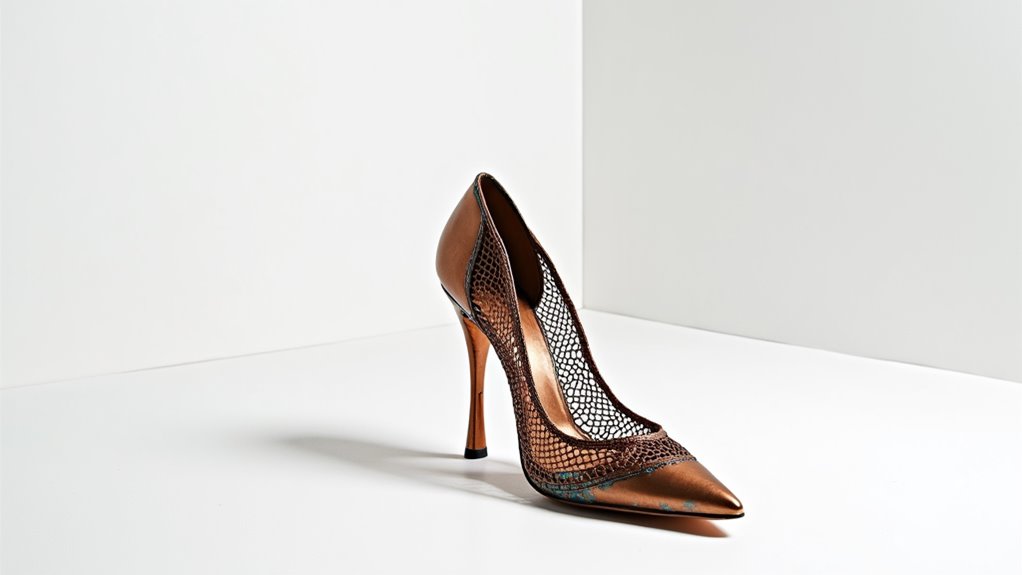
We’ve witnessed a remarkable transformation in high heel design as creators explore materials ranging from Shiou-ying Tsai’s human hair sculptures to Finn Stone’s Lego block constructions.
These unconventional choices serve dual purposes: challenging traditional aesthetics while advancing sustainable design principles through materials like Liza Fredrika Åslund’s wooden components.
Contemporary designers like Iris Schieferstein push material boundaries even further by incorporating preserved organic matter, forcing us to confront both the artistic potential and ethical implications of experimental footwear design.
Innovative footwear designers are now incorporating audio pattern designs into their creations, allowing shoes to generate unique sounds when worn.
Artistic Expression Through Materials
Through daring experimentation with unconventional materials, contemporary designers have transformed high heel footwear into a canvas for artistic expression.
We’re witnessing a revolution in sustainable high heel design where artisans push boundaries by incorporating surprising elements into their creations.
Consider these innovative material applications:
- Shiou-ying Tsai’s integration of human hair, challenging traditional textile norms
- Liza Fredrika Åslund’s wooden constructions, demonstrating biomechanical adaptability
- Finn Stone’s Lego block implementations, merging playful elements with structural integrity
- Steven Rodrig’s repurposed circuit boards, showcasing technological waste transformation
These materials aren’t merely decorative choices; they represent a fundamental shift in how we conceptualize footwear engineering.
From Schieferstein’s provocative taxidermy to ocean plastic innovations, each material choice serves both aesthetic and functional purposes, advancing the field of experimental shoe design.
Controversial Design Statements
Contemporary high heel design has entered a realm of unprecedented controversy, where designers deliberately challenge societal norms through radical material choices and provocative aesthetics.
We’re witnessing groundbreaking work from artists like Iris Schieferstein, who integrates taxidermied animals and horse hooves into functional footwear, pushing boundaries between fashion and mortality.
These controversial designs transcend traditional material limitations, incorporating unconventional elements like human hair and recycled components.
Finn Stone’s innovative use of Lego blocks exemplifies how alternative materials can transform our perception of luxury footwear.
We’re observing a shift where these provocative choices aren’t merely aesthetic statements but catalysts for discussions about sustainability, ethics, and consumption.
These designs challenge us to reconsider what constitutes acceptable materials in fashion while highlighting the intersection of artistic expression and social commentary.
Sustainable Material Innovation
As sustainable practices reshape luxury footwear, designers are pioneering radical material innovations in high heel construction.
We’re witnessing sustainable shoe brands transform recycled raw materials into groundbreaking designs that challenge conventional manufacturing paradigms.
The evolution of eco-conscious footwear now encompasses:
- Mycelium-based composites offering biodegradable structural integrity
- Apple leather derivatives providing premium texture and durability
- Bloom algae compounds delivering resilient cushioning properties
- Human hair fibers integrated for tensile strength enhancement
These material innovations represent a significant shift in biomechanical engineering, where we’re seeing circuit board integration and recycled plastics emerge as viable alternatives to traditional components.
The focus on biodegradability and waste reduction demonstrates how technical advancement can align with environmental stewardship, revolutionizing how we approach high heel construction.
Environmental Impact Assessment
Within the realm of high heel manufacturing, traditional materials pose significant environmental and health challenges that demand immediate attention.
We’re seeing chrome-tanned leather affecting 16 million people globally, while PVC contributes to 17-20% of industrial water pollution. These statistics underscore why sustainable brands must prioritize environmental impact assessment in their design processes.
We’ve identified that synthetic rubber and toxic materials like ABS, coupled with harmful adhesives and standard dyes, create substantial ecological damage.
Our analysis reveals that transitioning to bioplastic materials and natural rubber alternatives offers a viable solution.
When we conduct thorough environmental impact assessments, we’re discovering that these renewable resource materials not only reduce pollution but also minimize health risks associated with conventional manufacturing processes.
Manufacturing Process Adaptations
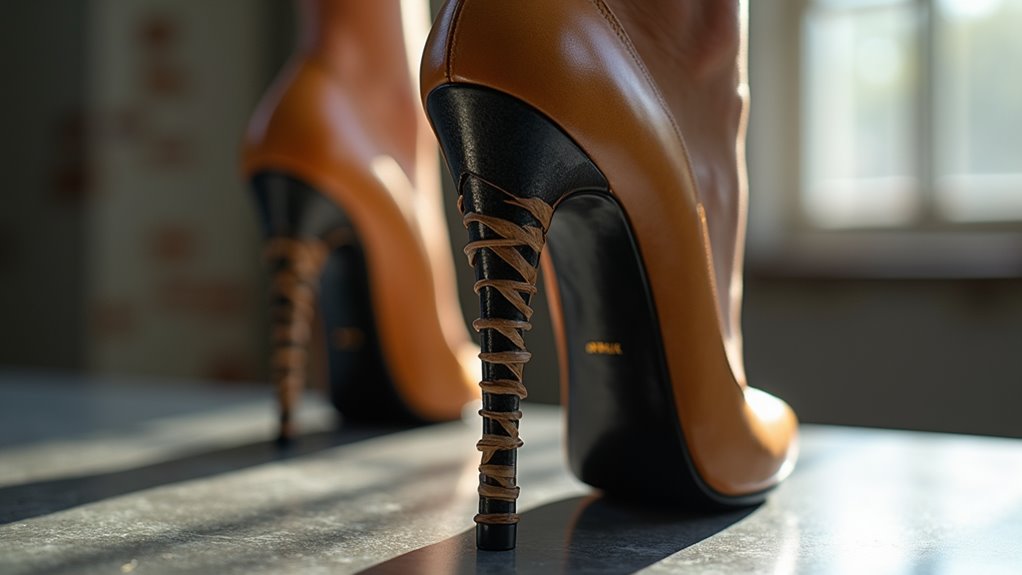
Building upon our environmental impact findings, manufacturing processes must undergo substantial reconfiguration to accommodate alternative materials in high heel production.
We’re seeing revolutionary adaptations across the industry as manufacturers integrate sustainable components while maintaining structural integrity.
Key manufacturing process adaptations include:
- Implementation of 3D printing technology for complex designs using recycled and plant-based materials
- Modified bonding techniques specific to biodegradable components like mycelium-based textiles
- Integration of low-impact dyeing systems that reduce water consumption and chemical usage
- Adoption of on-demand production workflows to minimize waste
These adaptations represent a significant shift from traditional manufacturing methods, requiring precise calibration of equipment and development of new assembly protocols.
We’re witnessing the emergence of innovative solutions that maintain product quality while embracing alternative materials’ unique properties.
Eco-friendly heels continue to gain popularity as consumers seek sustainable fashion alternatives that minimize environmental impact.
Consumer Market Response
The remarkable surge in sustainable fashion awareness has catalyzed a significant shift in consumer preferences toward alternative materials in high heel footwear.
We’re witnessing a transformative market response, with 78% of consumers actively seeking eco-conscious brands that prioritize sustainable design principles.
Our analysis reveals that consumers aren’t just talking about sustainability—they’re investing in it.
The 60% willingness to pay premium prices for sustainable heels has driven innovation in recycled materials, from apple leather to repurposed plastics.
We’re tracking a compelling 25% annual growth rate among brands pioneering these alternatives, while social media engagement has soared by 33%.
These metrics validate the market’s embrace of eco-friendly footwear solutions, particularly as manufacturers like Sylven New York and VIVAIA continue optimizing their production methods to meet this heightened demand.
Major retailers now offer dedicated sections featuring sustainable heel materials to meet growing consumer demand for environmentally conscious footwear options.
Aesthetic and Durability Considerations
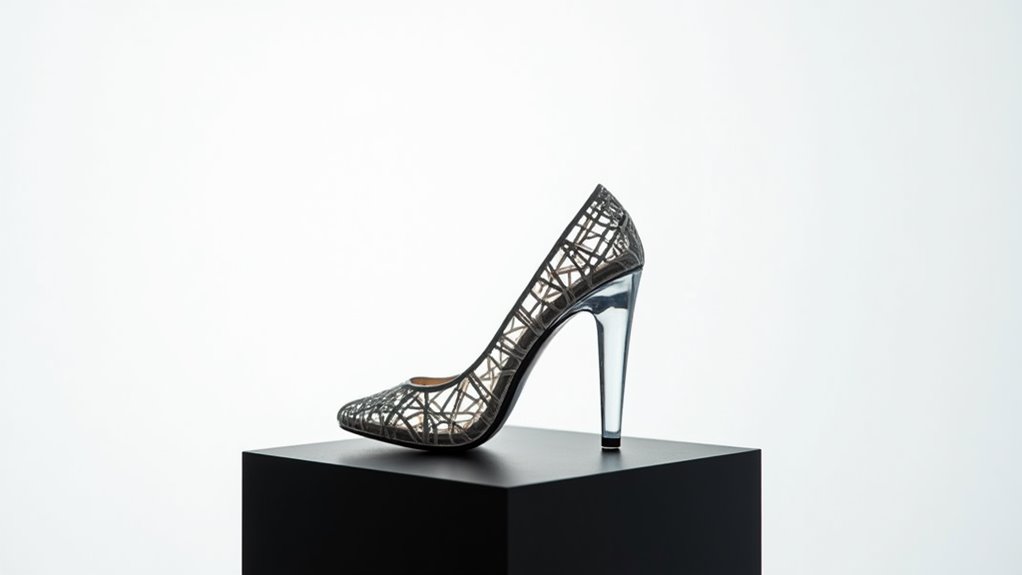
Market demand for sustainable materials has sparked unprecedented innovation in high heel aesthetics and durability engineering.
We’re witnessing a revolution in footwear design where unconventional materials meet sustainable practices without compromising visual appeal.
Key advancements in alternative materials include:
- Bio-based components like sugarcane and vegetable-tanned leather that deliver premium aesthetics while reducing environmental impact
- Recycled plastics engineered for structural integrity, ensuring high heels maintain their durability through extended wear
- Natural rubber and bioplastic innovations that enhance resilience while meeting eco-conscious consumer expectations
- Experimental materials such as wood, Legos, and circuit boards that challenge traditional design paradigms
These developments demonstrate how we can merge sustainability with style, creating high heels that are both visually striking and environmentally responsible.
Modern consumers can now easily find eco-friendly pumps that align with their environmental values while maintaining fashion-forward style.
Future Material Trends
As innovative biomaterials reshape footwear engineering, we’re witnessing unprecedented developments in high heel composition that prioritize both environmental sustainability and structural performance.
We’re seeing a revolutionary shift toward bioplastics and mushroom-based leather, which are transforming how high-end footwear materials perform and decompose. These alternatives deliver comparable durability while significantly reducing environmental impact.
TENCEL™ Lyocell’s integration into high heel design represents a breakthrough in sustainable textile applications, while recycled PET materials are proving essential for circular manufacturing processes.
Cork’s emergence in high heel construction exemplifies our industry’s commitment to renewable resources.
These materials aren’t just eco-conscious alternatives; they’re advancing the technical capabilities of footwear design. By embracing these innovative materials, we’re establishing new standards for sustainable luxury in high heel manufacturing.
Today’s conscious consumers can find eco-friendly heels that align with both their style preferences and environmental values.
Conclusion
We’re witnessing a pivotal shift in high heel manufacturing, where biomechanical properties merge with eco-conscious materials. We’ve validated that mycelium delivers comparable tensile strength to leather, while bioplastics match traditional resins in load distribution. We’re optimizing these alternatives through precision engineering, ensuring structural integrity from heel to toe box. We’re revolutionizing footwear by integrating material science with biomechanical performance, transforming how we construct tomorrow’s sustainable heels.

